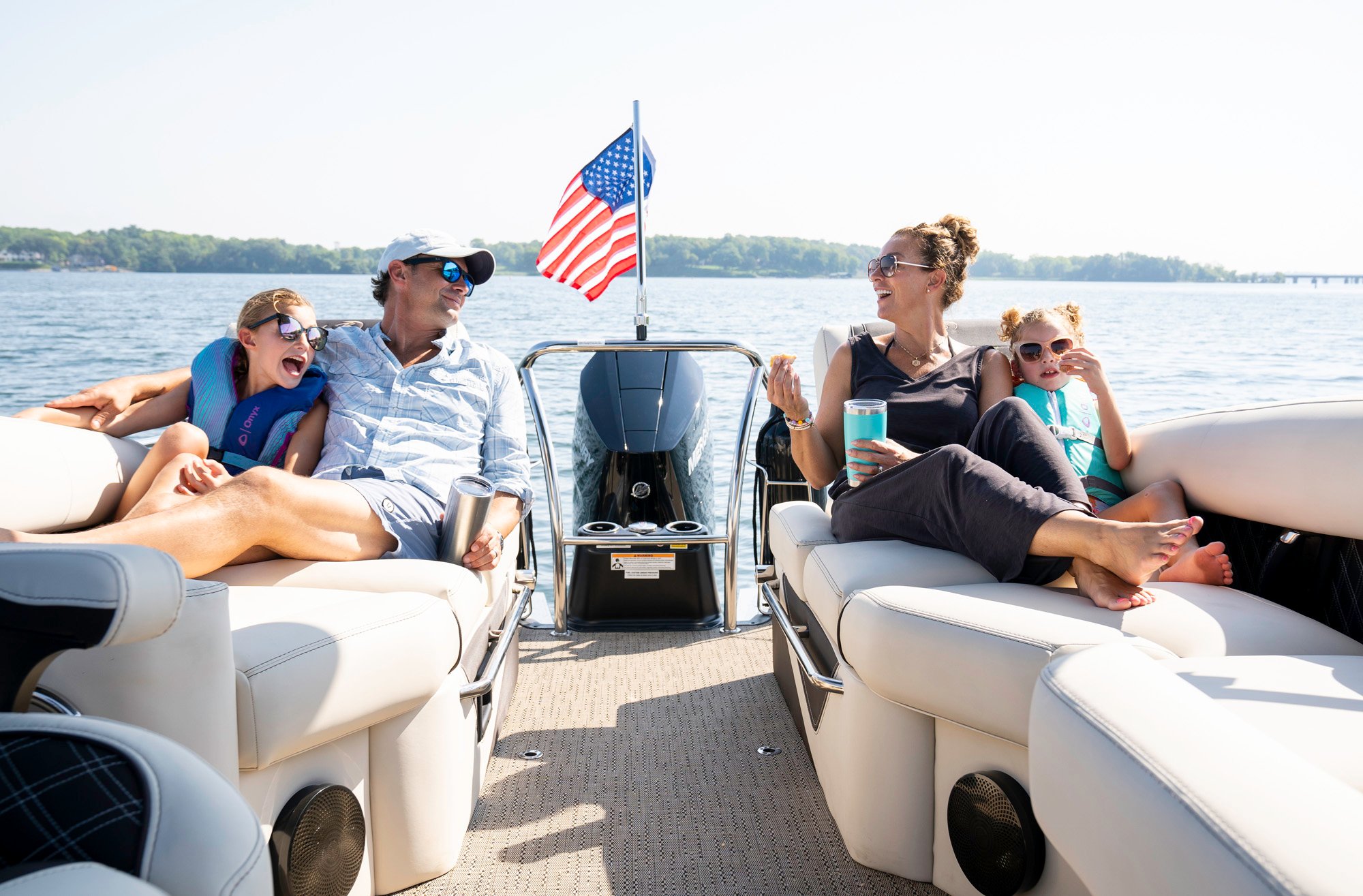Lifejacket and PFD 101 (How to Choose)
It’s no secret that boaters’ safety should be top of mind for anyone on the water. Whether you’re the captain of a sailboat, own a pontoon, like to kayak, or enjoy a fast ride on a personal watercraft (PWC), you need to know your legal limitations.
Safety on the water includes things like who has the right of way, knowing what navigation lights indicate, the type of gear you must have on board, and many other factors. One thing, in particular, should be top of the list and that’s what type of lifejacket you should have.
Are you aware of the term personal flotation device? Or what is the difference between a lifejacket and a personal flotation device? Do you know out of the five PFD types which is the best for your family?
There’s a lot of knowledge surrounding this piece of safety equipment and being in the know could very well save your life or the life of someone you love. If you get anything from this article I hope you understand how important lifejackets are and why you should have them with you any time you’re on the water.
The Importance of Lifejackets
The purpose of a lifejacket often referred to as a lifevest, is to give buoyancy to a person in the water who cannot keep themselves afloat or keep their head above water. They are critical in dangerous situations, keep those who cannot swim safe near water, and can save a person’s life if they find they’re too weak to swim.
That’s why the U.S. Coast Guard requires every boat to have a USCG-approved lifejacket for each person onboard the boat. I like to keep enough lifejackets stowed away to meet the capacity of the boat at all times so that we’re always covered.
That way, if we have unexpected visitors join us on the water, we have enough lifejackets to go around. Lifejackets, or personal flotation devices (PFD), must be USCG approved to meet legal requirements.
They must also properly fit the person that’s wearing it. Meaning, if the jacket is too big, the person is at risk of it slipping off while in the water putting them in a dangerous situation. Just the same, if the jacket is too small and doesn’t buckle all the way, the jacket will be less effective in the water.
Having a lifejacket for each person on your boat is important, making sure those jackets fit everyone is just as important. There are many different criteria that your PFD needs to meet to be legal depending on what activities you’re doing. You can also get all of this information by taking a boater's safety course or studying your local and state water rule book.
[For a full list of lifejacket requirements, visit the USCG website here: USCG Lifejacket Info Site]
Comfort is Key
When choosing a lifejacket for a person of any age, comfort should be considered. Most will be labeled with size and user weight limitations. Once you find the right fit, check to make sure there’s enough buoyancy by putting it on and jumping in. The lifejacket should keep your head above water and help you stay afloat with minimal effort.
You especially want to find a lifejacket that’s comfortable to wear if you’re an avid watersports enthusiast. You may be required by law to wear a lifejacket while being towed behind a boat for any type of sport.
Those who operate PWCs, sailboats, and other recreational vessels such as kayaks might also be required to wear one by law. A great way to learn about what your local and state laws require while boating is by taking a boater’s safety course and obtaining a boating license.
Child Lifejackets
Federal law requires that any child under 13 must wear a lifejacket while the boat is in motion. Depending on where you live, the state laws may vary and the age requirements could be lower. There are also exceptions when below deck or in a cuddy cabin.
Make sure to check your local and state laws regarding children’s life jackets. The most important thing is that the jacket fits the child, so adult sizes may not work. There are child-sized lifejackets available for all ages.
When choosing a lifejacket for a small child, you want to make sure it’s secure without the possibility of slipping off. It’s also important that the child is comfortable as they’ll be less likely to fight having to wear it on the boat.
Lifejackets vs Personal Flotation Devices
There are five types of personal flotation devices also called PFDs. PFDs are meant to provide buoyancy to someone in the water who cannot keep themselves above water. It’s important to know that a lifejacket is a PFD but not all PFDs are lifejackets.
That’s because a type IV PFD is actually a throwable flotation device and cannot be worn as a lifejacket would. The other four types are wearables and each has its own purpose. All five PFD types are U.S. Coast Guard approved.
Types of Lifejackets
Type I
The type I PFD is a wearable lifejacket and it’s intended to turn an unconscious person from face down in the water to straight up and down with their head tilted slightly back. This is critical as someone who’s not conscious cannot remove their head and face from the water therefore potentially resulting in drowning.
This type of lifejacket has the greatest amount of buoyancy and can greatly increase the chance that the unconscious person will survive. These PFDs are designed to be used primarily for offshore boating.
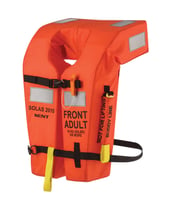
Type II
A type II PFD is also wearable and much like type I, it’s intended to turn the person who’s wearing the jacket around in the water. This will help them keep their head and face out above the water allowing them to breathe if they’re struggling to stay afloat.
These are intended for recreational boating on lakes and smaller water than offshore bodies of water. They are not a bad choice to keep on your boat and can be purchased as a pack of multiples. We buy these in packs of four and keep enough on our pontoon boat to meet the person capacity.
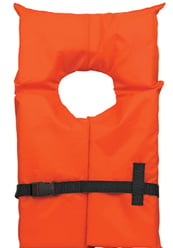
Type III
The type III PFD is a wearable lifejacket but it’s not designed to turn a person around in the water as type I and II are. It is intended to support a conscious person so that they sit upright in the water.
These are the common types of lifejackets or lifevests you will see someone who is wakeboarding or driving a jet ski wear. They are usually made to be a comfortable vest-like jacket and many times are made of neoprene material.
They’re not intended to be worn if you’re going to be in rough water or there’s a potential for a dangerous situation that requires the victim to be turned around in the water.
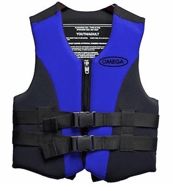
Type IV
As I mentioned previously, the type IV PFD is a throwable flotation device. This is the only PFD that’s not wearable. Its intended use is to be thrown to someone who is overboard in the water struggling to stay afloat.
You will find that there are a few different designs of throwables. The different shapes that are most common are square, ring, or horseshoe style. The ring shape is most iconic to the nautical lifestyle but the square type is popular for recreational boating.
Most recreational boats are required by law to have one throwable PFD on board at all times. It must also be within arm’s reach so that it’s readily accessible at the time of need. Make sure to check what laws pertain to the size and type of boat you have, depending on the length this law may vary.
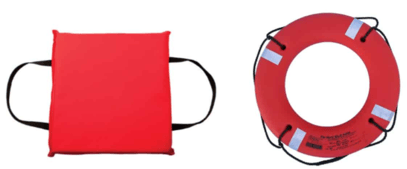
Type V
This type of PFD is the least common when it comes to everyday recreational boating. The type V lifejacket is intended for particular situations such as white water outings and sail racing.
It fits more as a harness and some of them inflate to become buoyant to make them more comfortable when wearing them regularly. These will not save an unconscious person by turning them around and should only be used if quick rescue is possible.
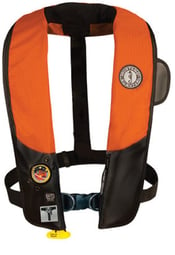
What Type of PFD is Best?
You should have some idea of what type of lifejacket will suit your needs best based on what activities you plan to do on the water. As I mentioned, we keep enough type II lifejackets onboard our pontoon boat at all times to comply with the law.
Often referred to as orange uglies, these are stowed away and would only come out if we found ourselves in a dangerous situation. When children board our boat, we make sure to have the right size PFD that’s also comfortable for them to wear.
Outside of those two, we keep a couple of type III life vests on board just in case the opportunity arises to tube behind the boat. These also come in handy if one of our passengers wants to jump on a jet ski at the sand bar.
Lastly, we keep the required throwable PFD on the boat at all times. We make sure it’s in a spot that is easily accessible at a moment's notice. This not only keeps us compliant with the law but is also a smart choice when boating on any type of water.
If you’re a recreational boater not planning on going offshore or unlikely to find yourself in a sailboat race, I recommend looking into these three PFD choices. We take our pontoon boat out on a medium-sized lake and these three have us more than covered.

